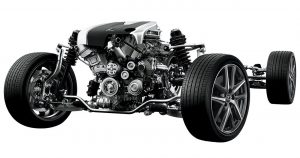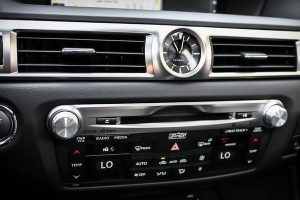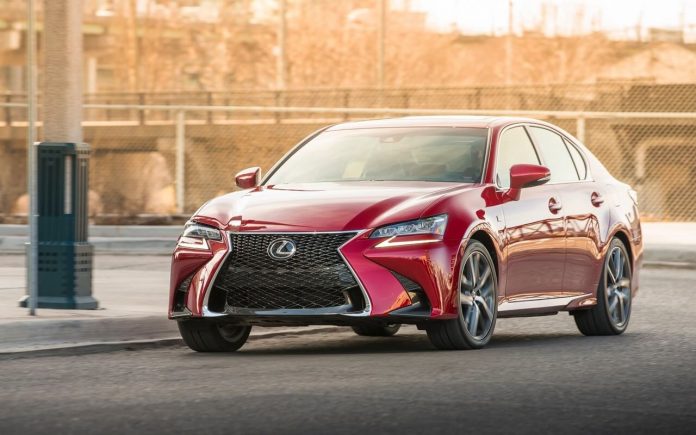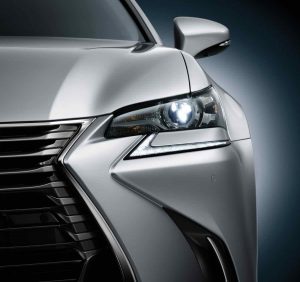What killed the Lexus GS350?
After 27 years in production it looks like 2020 will be the final year for this mid-sized luxury-sport sedan, which was one of the first of its kind not made by BMW or Mercedes-Benz.
Lexus sold it for less than BMW and Benz charged for their mid-sized luxury-sport sedans, models like the E-Class and 5-Series. And gave you more.
As well as less, in the form of lower – and slower – depreciation.
A Lexus luxury-sport sedan was likely to be worth more after you paid it off than its BMW or Mercedes equivalent – and last longer without costing you more, too.
All of that’s still true today – which makes it a sad day because the GS is going away, for reasons that have little to do with its merits relative to its rivals but rather because luxury-sport sedans as a class just aren’t selling well anymore as the market shifts over to luxury-sport crossovers.
The GS350 is a mid-sized luxury-sport sedan available in rear drive and AWD configurations.
Unlike most of its rivals, this one still comes standard with a V6 rather than a turbocharged four – and it costs less than most of them do, too.
Prices start at $51,395 for the rear-drive version and – interestingly – $51,065 with AWD. Read that again. Lexus has priced the AWD version of the last-of-the-line GS slightly below the price of the RWD version.
Contrast these MSRPS with the base price of the rear-drive BMW 5-Series ($53,900) and the rear-drive Mercedes E350 ($$54,050). If you opt for AWD the price of the BMW rises to $56,200. The Benz goes up to $56,550.
And both come with much smaller – and less powerful – 2.0 liter fours while the Lexus comes standard with a 3.5 liter V6.
A top-of-the-line GS350 F Sport with an adaptive suspension, high-performance brakes, a 19-inch high-performance wheel/tire package and AWD stickers for $54,505.
The GS350’s strongest rival is probably the Genesis G80 – which also comes standard with a big V6 and a lower sticker price ($42,550 to start).
What’s New
For its swan song year, Lexus is offering a Black Line edition – available in either Caviar White or Ultra White on the outside, with unique black leather interiors, trimmed with Rioja Red stitching and carbon fiber accents.
Only 200 of these will be made.
One of the best deals going for a car of this type.
One of the strongest standard engines in the class.
Spacious trunk.
What’s Not So Good
RWD version comes with a less aggressive 2.9:1 final drive ratio than AWD version (3.7:1).
Toggle/mouse input for the Infotainment system isn’t as easy to use as buttons and knobs.
Though powerful relative to rivals, the ES350 compares less favorably with relatives like the Toyota Camry and Lexus ES350, which offer essentially the same V6 with essentially the same power for a great deal less money.
Under The Hood
Every GS350 – including the F Sport – comes standard with a 3.5 liter V6 that makes 311 horsepower and 280 ft.-lbs. of torque. This engine is the same well-regarded engine used in several other Lexus – and Toyota – models and has earned a reputation for being exceptionally reliable and long-haul trouble-fee. 
It is also one of the largest and strongest standard engines in the class, far more so than the 248 hp, 2.0 liter turbocharged four cylinder engine that is standard in the BMW 5 sedan and the 255 horsepower 2.0 liter turbocharged four that’s standard in the Mercedes E350.
It’s pretty remarkable that $50k luxury-brand cars come standard with four cylinder engines that hardly make more power than the four cylinder engines that come standard in many $25k family cars. It used to be a given that you got a V6 in a car in the GS350’s range.
Now, the GS350 is pretty much the only car in its range that comes standard with one.
There is the Infiniti Q50 – which does come standard with a V6 that’s almost as large and nearly as strong (3.0 liters, 300 horsepower) but it’s a smaller, almost compact-sized car and so not really a direct cross-shop. And the Genesis G80 – which is about the same size but has a much smaller trunk and a tighter back seat.
The biggest problem for the GS may be another Lexus – the ES350 – which is a larger car with a lower price ($39,990 to start) that comes with the same 3.5 liter V6, though rated in this car as making 302 hp rather than 311. It’s not a huge difference. But the price is.
So what’s the catch?
The ES350 is a front-drive car and doesn’t offer AWD. It leans toward the luxury side of the luxury-sport aisle, while the GS350 leans more toward the sport side. It’s not really a case of better or worse but different strokes for different folks.
The transmission you get depends on the layout you choose.
Rear-drive versions come with an eight-speed automatic. Those equipped with the optional all-wheel-drive system get a six-speed automatic.
Interestingly, both have two overdrive ratios – 7th and 8th in the eight speed box and 5th and 6th in the six-speed. Not three for the eight speed (and two for the six). The eight-speed transmission has tighter gear spacing, first-through fifth, vs. first through third for the AWD’s six-speed transmission – including a really deep 4.596 first gear ratio vs. 3.520 in the six speed.
But the AWD GS gets a more aggressive 3.7:1 final drive ratio vs 2.937 for the rear-drive GS so both end up being about equally quick, achieving 60 MPH in 5.7 seconds (with RWD) and 5.8 (with AWD) a difference impossible to discern without a stopwatch.
There is a big difference on top, though.
The rear-drive GS is capable of 143 MPH while the AWD version is electronically limited to 130 MPH.
A turbo can make up for making an engine smaller – provided there’s enough boost to make up for the lost cylinders. But there are intangibles that a turbo can’t replace, including the sound made by a V6 as opposed to a four.
This is the reason why fours have until pretty recently been found under the hoods of economy cars and lower-priced cars rather than $50k luxury-sport cars. But the pressure – applied by government regulations – to up the MPGs of all cars, even luxury-sport cars (the buyers of which we can safely assume prioritize other things) has resulted in a displacement-winnowing, even under the hoods of $50k luxury-sport cars.
The GS still has its V6 because the GS hasn’t been redesigned lately. The current model dates back to 2013 and so was designed a couple of years before that – at a time when its designers never imagined they’d have to squeeze 35 MPG on average out of a car in this class. A V6 was expected – and so that’s what went under the hood of the GS.
Which brings up that intangible. What’s expected.
If you jumped into a time machine and went back 25 years and tried to sell luxury-sport prospects a $50k car with a four cylinder engine they’d laugh in your face. Who would pay $50k to drive a car with an engine the same size as his neighbor’s $20k economy car?
But it’s becoming hard not to pay to drive one, as that’s increasingly all that’s available – even for $50k.
Here, you get the pride of owning a V6 rather than a measly four – with a great deal more power than those measly fours, too.
Beside which, the sound.
When you give it gas, you hear the baritone song of six, not the prepubescent song of four. It is true the torque spread of the four is more generous but that misses the point. The GS’s V6 enjoys a spin to the right side of the tach and so will you.
You may also enjoy the absence of ASS – the automated stop/start “feature” almost every new car now comes standard with, including the GS’s rivals from Benz and BMW. The GS350’s V6 shuts off when you shut it off. As opposed to it shutting itself off at every red light and pause in traffic, as ASS-equipped cars do.
The ride and steering – even in Sport mode – lean toward the luxury side of the aisle, for a car of this type. The F Sport with its adaptive suspension and more aggressive 19-inch “summer” tires is much improved in this respect – and relative to the ES350, which is otherwise a contender in the curves, notwithstanding its FWD layout.
What’s missing is more horsepower. A $50k GS 350 ought to have more of it than a $39k ES350 – to say nothing of a $30k Camry.
Especially the $52k F Sport, which has the rest.
Lexus kind-sorta does offer the rest – and more – in the GS F, which has a 5.0 liter, 467 horsepower V8 under its hood. This one delivers the goods – including zero to 60 in four seconds. But this kind of speed costs $85k – and that put it out of reach for practically all of us.
Aside from general trends in favor of crossovers, the other problem besetting luxury-sport sedans is their lack of one-car-does-it all practicality – the attribute which helps explain the trend in favor luxury-sport crossovers.
But the GS350 is exceptionally practical . . . vs. other luxury-sport sedans.
Behold the 18.4 cubic foot trunk – a vast space compared with the small space offered by the Benz E-Class sedan (13.1 cubic feet) and the 15.3 cubic feet in the G80… as well as the lesser space (16.7 cubic feet) in the ES350, which is a larger car in terms of overall length (192.1 inches bumper to bumper vs. 195.9 inches).
The problem for all luxury-sport sedans is how much more practical luxury-sport crossovers are. For example, the hugely popular Lexus RX350 (which comes standard with the same 3.5 liter V6) and is almost exactly the same overall size in terms of its footprint (192.5 inches long) has 18.4 cubic feet of space behind its back seats and 56.3 cubic feet with its back seats folded down.
That’s three times as much space for “stuff” as the GS350’s got and that plus the snow-fording advantage of being higher off the ground makes the RX more appealing to people who need a family car that’s also a luxurious and a sporty car.
Even if it technically isn’t a “car.”
The GS may not have as much cargo room – or ground clearance – as a crossover but it does have a very generous list of standard amenities going for it, including a 12-speaker premium audio system (with a CD player) and a larger-than-most 12.3 inch LCD display, a standard sunroof and leather seats.
Available options include an even more premium 17-speaker Mark Levinson sound system and – F Sport models – a four-wheel steering system (DRS) to further uptick this car’s cornering capabilities. It should be mentioned here as well that the available AWD system is set up to deliver a rear-biased 30/70 (front to rear)power split, to maintain the feel of a rear-drive car when the cornering upticks.
The Rest
Most $50k cars have a smartphone-emulating interface to control secondary functions – in order to set them apart from $25k cars that have knobs and buttons to control them. Whether this is an improvement will depend on whether you like tapping and swiping to control things.
The Lexus system does have ergonomics in its favor.
There is a soft pad on the center console for your right hand to rest on, with a small forward-back/left-right toggle you can use to “mouse” your inputs to the LCD screen. The toggle has some drag built into it so there’s more feedback than the more common finger swipe/pinch/tap method used in other $50k cars – but it’s arguable that a simpler button or knob would serve the same function with less elaboration.
The Bottom Line
The GS goes away with 2020 which is only about six weeks from now. So if you want one under your tree, don’t wait on Santa.
. . .
Got a question about cars, Libertarian politics – or anything else? Click on the “ask Eric” link and send ’em in!
If you like what you’ve found here please consider supporting EPautos.
We depend on you to keep the wheels turning!
Our donate button is here.
If you prefer not to use PayPal, our mailing address is:
EPautos
721 Hummingbird Lane SE
Copper Hill, VA 24079
PS: Get an EPautos magnet or sticker or coaster in return for a $20 or more one-time donation or a $10 or more monthly recurring donation. (Please be sure to tell us you want a magnet or sticker or coaster – and also, provide an address, so we know where to mail the thing!)
If you’d like an ear tag – custom made! – just ask and it will be delivered.
My latest eBook is also available for your favorite price – free! Click here. If that fails, email me at [email protected] and I will send you a copy directly!


















Toyota said they are getting rid of v8s for all cars under 100k. Turbo v6 are gonna be the v8 replacement. Makes me want to buy a dodge charger before the v8 becomes a very rich man’s option only.
You should do it, Mooeing… while you still can.
The (s)election of Biden assures the end of the Charger/Challenger… at least, as mass-market cars that normal people can afford.
Eric,
What I don’t understand is why luxury car makers CARE about gas mileage! If someone can afford to pay $50K or more for a car, another few grand (for gas guzzler tax) won’t stop them. For someone spending less than $50K, I could see a few grand mattering; I don’t see how it would stop someone who can afford to spend $50K or more on a car. It’s a TRAVESTY that cars in this class have fours-a shameful travesty! It’s just wrong to put a four in a car like this. The least they should have is V6s, though a V8 or V12 is more BEFITTING this class of car…
For that matter, it’s a CRIME that Ford is offering the Mustang with a 2.3 L four! I know, I know; it makes more power than the 5.0 L V8 did a few short years ago. That said, the Ford Pinto had a 2.3 L four. Mustangs come with the SAME SIZE ENGINE as the Pinto! Am I the only one who sees that as wrong? A Mustang, at minimum, deserves good, strong V6; a V8 is more appropriate for it though.
Put fours where they belong-in small cars…
Always been a great sedan. IMO the grill didn’t do it any favors with the cars typical conservative customers.
Four-cylinder engines in 50k “luxury vehicles” – amazing. I like to refer to their power source as Vega and Pinto engines or Ford Model T engines. If folks would just stop buying these luxury “fakes” maybe the manufactures would get the message.
The Toyota/Lexus 3.5 liter V6 is a well-designed great engine – I’ve got it in two vehicles. Neither has consumed any oil between changes – 6k miles.
Hi liberty,
It wasn’t all that long ago that luxury vehicles had V8s – and some V12s.